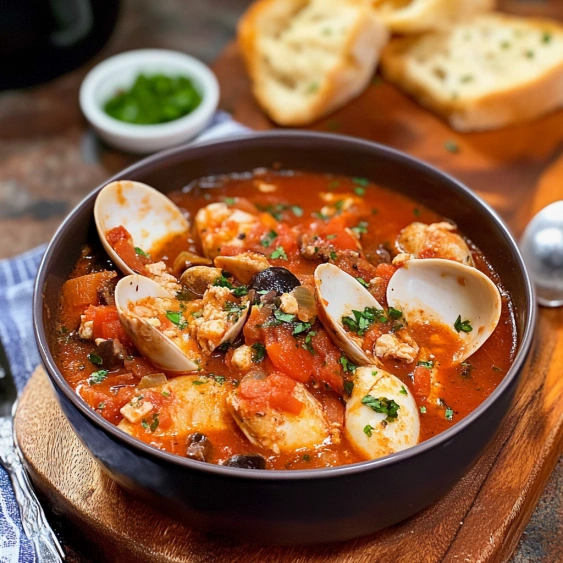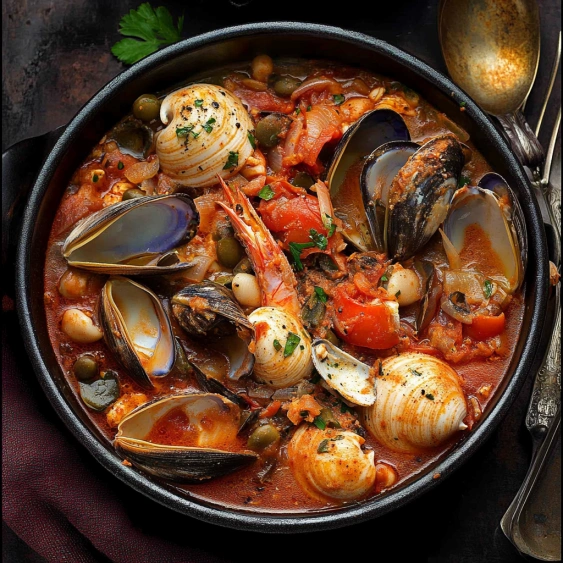 Pin it
Pin it
This hearty Cioppino seafood stew transforms the bounty of the sea into a rich, flavorful meal that's both impressive and surprisingly simple to prepare. The robust tomato broth creates the perfect backdrop for tender seafood, while aromatic vegetables and herbs add depth that makes every spoonful memorable.
I first made this Cioppino for my family's Christmas Eve dinner three years ago, and it's now our most anticipated holiday tradition. The way my daughter's eyes light up when she sees the steam rising from the pot tells me this recipe has truly become part of our family story.
Ingredients
- Olive oil: creates the foundation for sautéing vegetables
- Shallots: provide a milder, sweeter flavor than regular onions
- Carrots: add natural sweetness and body to the broth
- Leeks: offer a delicate onion flavor that doesn't overpower the seafood
- Garlic cloves: infuse essential aromatic notes
- Dry white wine: brings acidity and complexity
- Fire roasted diced tomatoes: contribute smoky depth
- Tomato paste: intensifies the rich tomato flavor
- Fish or seafood stock: forms the backbone of the broth
- Bay leaf: imparts subtle herbal notes during simmering
- Red pepper flakes: add customizable heat
- Dried herbs: like parsley, oregano, and thyme create the classic Italian profile
- Sugar: balances acidity from tomatoes and wine
- Mussels: add briny sweetness as they open and release their juices
- Clams: provide distinctive oceanic flavor and textural contrast
- Jumbo shrimp: deliver that perfect snap and sweetness
- White fish: contributes flaky texture and mild flavor
Step-by-Step Instructions
- Prep All Ingredients:
- Dice shallots and carrots into small uniform pieces for even cooking. Thinly slice leeks after thoroughly washing between layers where sand hides. Mince garlic finely for optimal flavor release. Measure all liquids and spices so they're ready to add. Thoroughly scrub mussels and clams under cold water, removing any "beards" from mussels. Pat white fish and shrimp dry with paper towels.
- Create Aromatic Base:
- Preheat a large Dutch oven over medium heat until you can feel warmth hovering an inch above the surface. Add olive oil and let it shimmer before adding shallots, leeks, and carrots. Sauté for 6 to 8 minutes, stirring occasionally until vegetables soften and develop light golden edges. This caramelization builds crucial depth of flavor.
- Incorporate Garlic And Wine:
- Add minced garlic to the vegetable mixture and stir constantly for 30 to 45 seconds until fragrant but not browned. Immediately pour in white wine to stop the garlic from burning. Allow wine to simmer for one full minute, which cooks off the alcohol while preserving the flavor compounds that enhance the seafood.
- Build The Tomato Broth:
- Add tomatoes with their juice, tomato paste, all dried herbs, red pepper flakes, bay leaf, garlic powder, sugar, salt, and fish stock. Stir thoroughly to incorporate tomato paste completely. Taste and adjust salt if needed. The broth should have vibrant flavor as it will be absorbed by the seafood.
- Develop Flavor Through Simmering:
- Reduce heat to maintain a gentle simmer with occasional bubbles breaking the surface. Allow the broth to cook uncovered for 20 to 25 minutes, stirring occasionally. This critical simmering stage allows the flavors to meld and intensify. Taste again and adjust red pepper flakes for your preferred spice level.
- Cook Shellfish:
- Add mussels and clams to the hot broth, gently pushing them below the surface. Cover the pot with a tight-fitting lid to create steam that will force the shellfish to open. Cook for 3 to 4 minutes until shells begin to open. Discard any that remain firmly closed after cooking.
- Add Remaining Seafood:
- Place chunks of white fish and shrimp into the broth among the shellfish, ensuring they're fully submerged. Cover again and cook for approximately 5 minutes until fish turns opaque throughout and shrimp transform from translucent to pink and opaque. Avoid overcooking which would toughen the seafood.
- Serve Immediately:
- Ladle the Cioppino into wide, shallow bowls making sure each serving gets a generous portion of each seafood type. Serve with slices of crusty sourdough bread for soaking up the flavorful broth. The vivid colors and enticing aroma make for a spectacular presentation.
 Pin it
Pin it
You Must Know
The diverse seafood in this Cioppino represents what I love most about coastal Italian cooking tradition where fishermen would contribute a portion of their daily catch to a communal pot. I find something profoundly connecting about continuing this tradition in my modern kitchen, especially when I see my family gathered around the table, warm bread in hand, ready to dive into this oceanic treasure.
Selecting The Best Seafood
Freshness is absolutely critical when making Cioppino. Look for seafood with a clean ocean smell rather than a strong fishy odor. For shellfish, only purchase those with tightly closed shells or that close when tapped. If buying frozen seafood, thaw it slowly in the refrigerator overnight rather than using quick thawing methods which can compromise texture. I recommend building a relationship with a local fishmonger who can guide you toward the freshest options available in your area.
Make Ahead Options
While Cioppino is best enjoyed immediately after preparation, you can prepare the tomato broth base up to two days ahead. Simply follow the recipe through the simmering stage, then cool and refrigerate the broth. When ready to serve, bring the broth back to a simmer before adding the seafood as directed. This makes the recipe perfect for entertaining since you can focus on your guests while quickly finishing the dish with spectacular results.
Flavor Variations
The beauty of Cioppino lies in its adaptability. For a Southern Italian twist, add a pinch of saffron threads during the broth simmering stage. Seeking deeper umami notes? Include a splash of fish sauce or a small amount of anchovy paste when building the broth. For a more herbaceous profile, finish with fresh chopped basil and parsley just before serving. Some West Coast versions include Dungeness crab when in season, which adds remarkable sweetness and makes the dish even more special.
Pairing Suggestions
Cioppino calls for crusty sourdough bread as its traditional accompaniment. The bread should be sturdy enough to soak up broth without disintegrating. For wine pairing, choose the same dry white wine you used in cooking, typically a Pinot Grigio or Sauvignon Blanc. If you prefer red, a light Pinot Noir works surprisingly well. Complete the meal with a simple arugula salad dressed lightly with lemon and olive oil to cleanse the palate between bites of the rich stew.
 Pin it
Pin it
Frequently Asked Questions
- → What type of white fish works best in cioppino?
Firm, mild white fish varieties work best in cioppino as they hold their shape during cooking. Good options include halibut, cod, sea bass, snapper, or haddock. Choose fresh fish that can stand up to the robust flavors of the broth without falling apart.
- → Can I make cioppino ahead of time?
You can prepare the tomato broth base up to 2 days ahead and refrigerate it. When ready to serve, reheat the broth to a simmer, then add the seafood in the specified order. This method ensures the seafood remains tender and perfectly cooked.
- → What can I substitute for the seafood stock?
If seafood stock isn't available, you can use chicken stock or vegetable broth as alternatives. For added seafood flavor, consider adding clam juice or the liquid from canned clams. You can also make a quick seafood stock by simmering shrimp shells with vegetables and herbs.
- → How do I know when the seafood is properly cooked?
Mussels and clams are done when their shells have opened wide (discard any that remain closed). Shrimp are cooked when they turn pink and opaque, usually in 3-5 minutes. White fish is done when it turns opaque and flakes easily with a fork. Avoid overcooking to prevent rubbery seafood.
- → What wines pair well with cioppino?
Cioppino pairs beautifully with the same dry white wine used in cooking, such as Pinot Grigio, Sauvignon Blanc, or unoaked Chardonnay. For red wine lovers, light to medium-bodied options like Pinot Noir or Chianti complement the tomato-based broth without overwhelming the delicate seafood flavors.
- → Can I add other types of seafood to cioppino?
Absolutely! Cioppino is versatile and can include other seafood like scallops, crab, lobster, or squid. When adding different seafood, consider their cooking times and add them in stages accordingly—longer-cooking items first, followed by quicker-cooking options.
